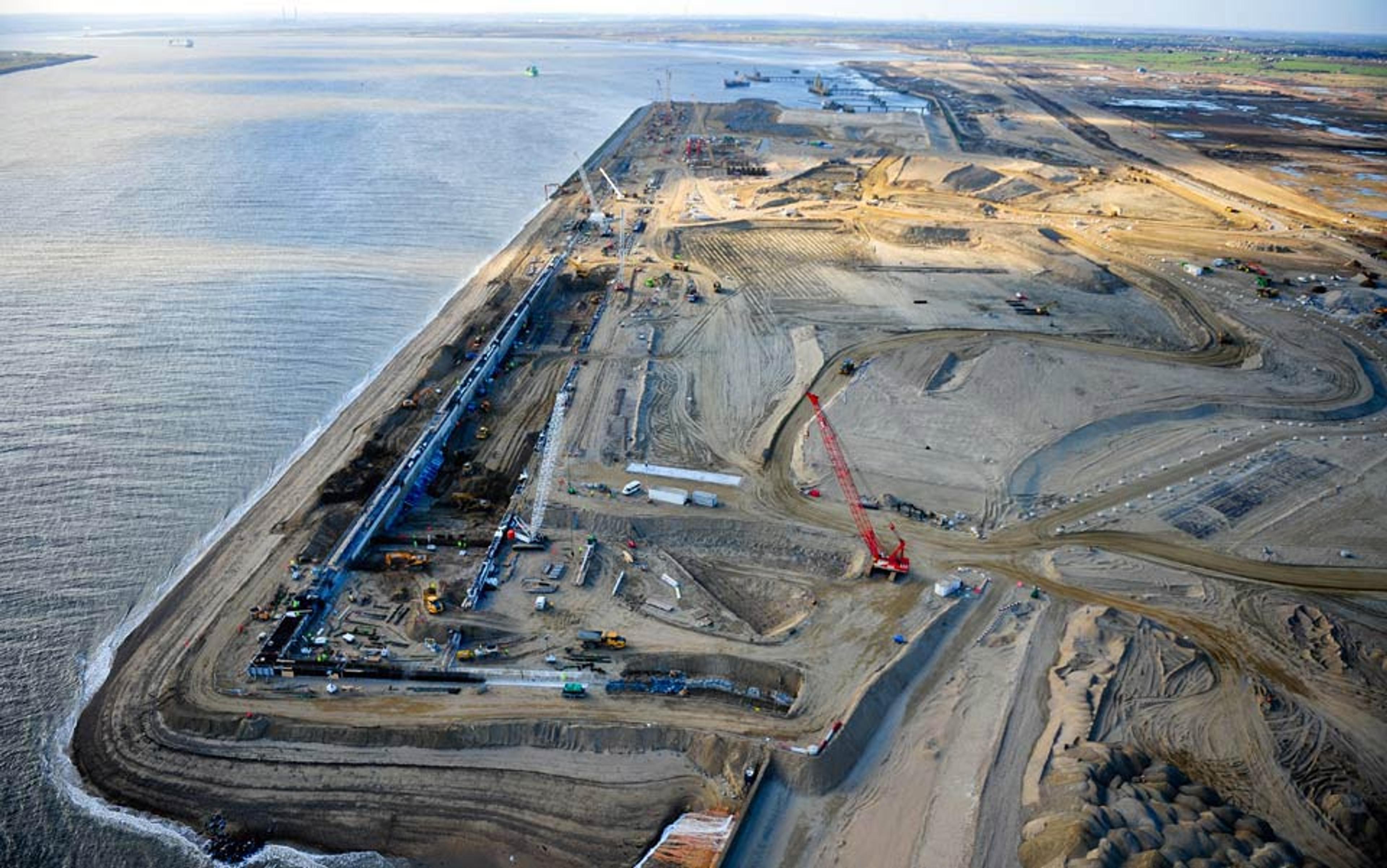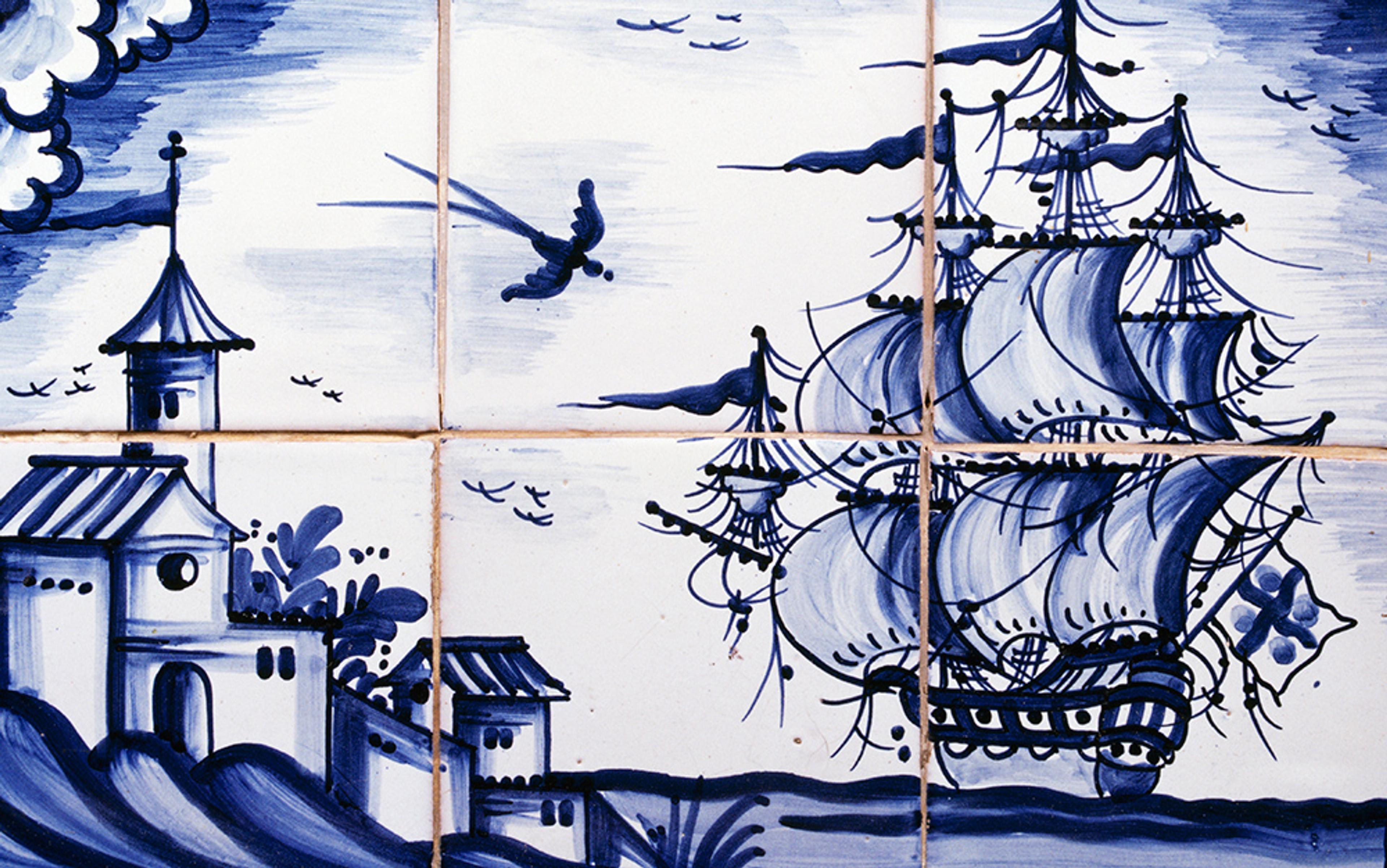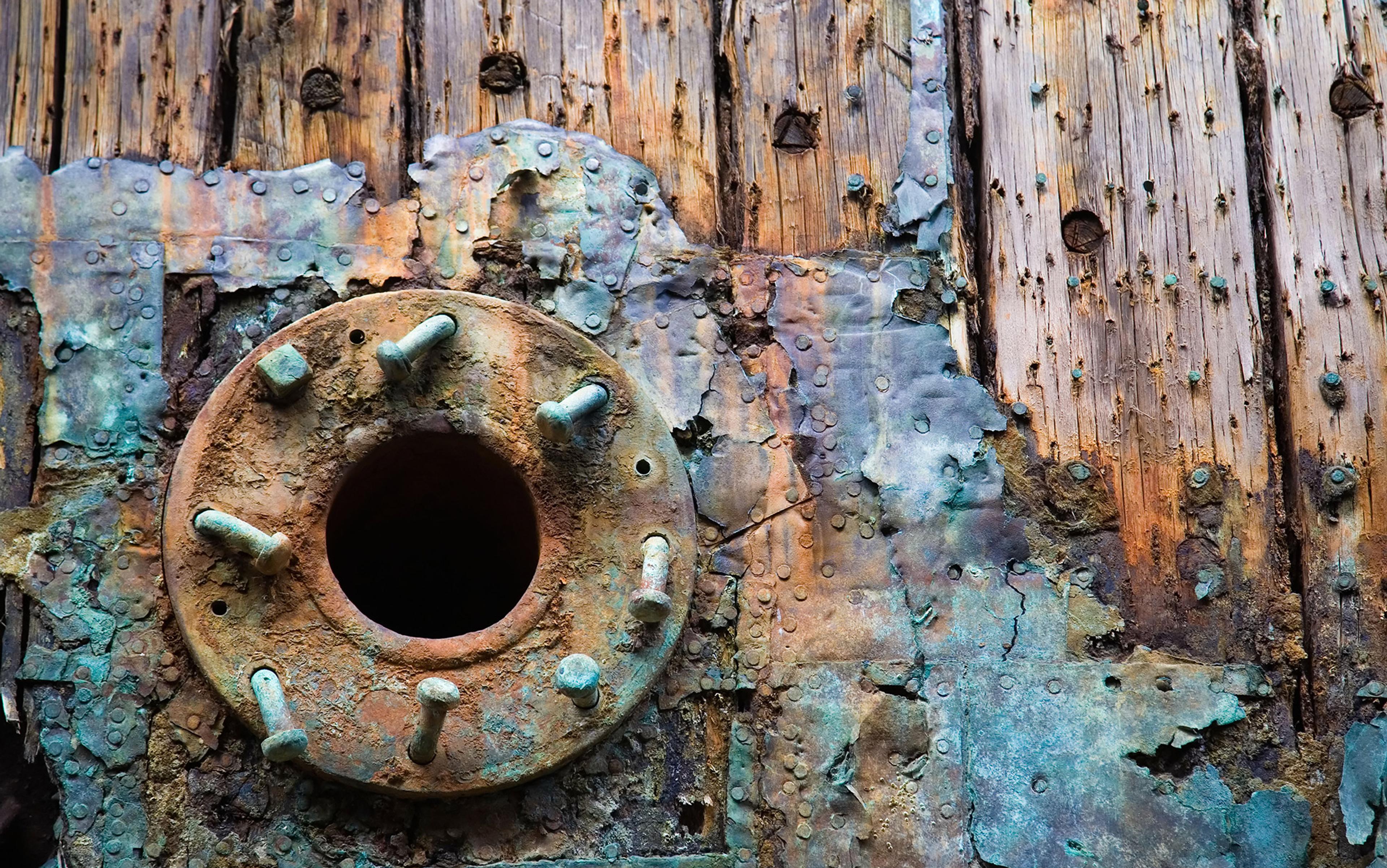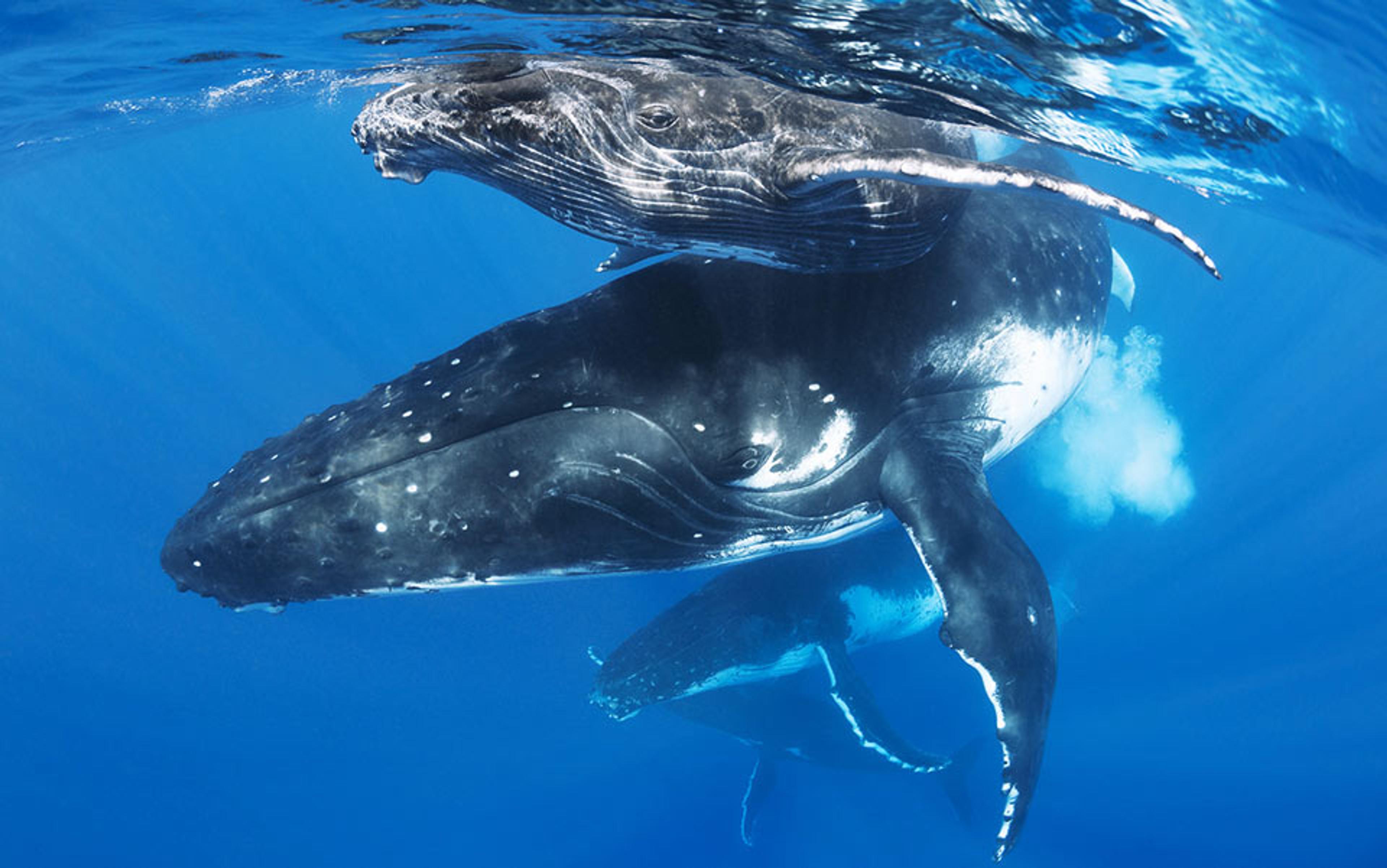The point where the tidal waters of the North Sea flow into the mouth of England’s longest river marks the outer reaches of the Thames Estuary: the gateway for international trade, industry and travel into London for millennia. Goods and people from all over the world have arrived in Britain via this well-used sea route from as far back as Roman times, when vast quantities of luxury commodities including pottery, marble, wine, olive oil and silver would travel downriver to Londinium from the furthest reaches of the Roman Empire.
For good or ill, a pattern of conspicuous consumption, fed by river trade, was soon established. In Anglo-Saxon times the city’s visible wealth, manifest in riverside monasteries, attracted unwelcome attention from Viking raiders, whose longboats swept up the estuary in the ninth century, tearing down early timber versions of London Bridge. When a stone London Bridge was completed in 1209, it was partly to bolster the city’s defences, and later attacks by pirates resulted in merchant ships being heavily armed with cannon.
These merchant ships — hulls creaking, sails billowing — came into the estuary from across the Mediterranean, bearing exotic goods from Europe and beyond; silks, spices, gold, and ivory. They also helped to establish sea power in the East Indies, which eventually led to the founding of the East India Company and the beginning of Britain’s Indian empire. But it was the 17th and 18th centuries that were the Golden Age of the Estuary, when this stretch of water was the major highway of the British Empire. Tea, silks, opium, salt, cotton and indigo dye flooded into the port of London from India, China, Bengal and other places in the Far East. Joseph Conrad described the Thames Estuary in the first few pages of Heart of Darkness (1899), capturing the imperial ambitions of the nation: ‘What greatness had not floated on the ebb of that river into the mystery of an unknown earth! … The dreams of men, the seed of commonwealths, the germs of empires.’
Hulking remnants of those great ships still exist on the sea floor — hidden witnesses to a boom-time of British exploration, colonisation and international trade. Many older vessels have also been recovered from the waters, including a Bronze Age paddle; a Roman cargo ship; a ninth-century Danish Viking longboat; an Elizabethan gun ship; a Tudor Thames brick barge; and a 17th-century warship, to name just a few. Likewise, hundreds of military ships met their fate on this geopolitically important stretch of water, some sunk by enemy fire, others victim to the shifting tides and sandbanks, others still, destroyed through unlucky accidents.
In fact, there are more shipwrecks per square metre in this place than anywhere else along the UK coastline, with 600 known wrecks in the deep shipping channel alone, and the remains of many more lodged in the treacherous sandbanks on either side.
The most visible of these wrecks rises out of the notoriously dangerous Maplin Sands at low tide, about a mile offshore from Shoebury East Beach, three miles from Southend in Essex. Known locally as Mulberry Harbour and built in the dockyards of Chatham, then towed upriver destined for Normandy, this gigantic concrete caisson would have been part of a floating deep-sea port for the D-Day landings in June 1944, but it snapped away from the tug, crashing on to the mudflats below, where it has remained ever since.
The S S Richard Montgomery, lying half-buried in the shifting sands of the Nore near the seaside town of Sheerness, is the most hazardous wreck in the estuary. This American Liberty ship ran aground there on 20 August 1944, loaded with nearly 7,000 tonnes of bombs and explosives. The crew was rescued and, during the next few days, most of the volatile cargo on board was removed. But before the process could be completed, the Montgomery broke her back on the sandbank and sank in a storm later that night, with more than 1,000 tonnes of munitions still inside. Dubbed the ‘Doomsday Ship’ by locals, the Montgomery is a broken, waterlogged, ticking time bomb.
Warning buoys mark the edges of the 500-metre exclusion zone around the wreck, which is monitored day and night by the Port of London Authority. Shipping routes have been diverted around the submerged boat for almost 70 years now, and pilots approaching Sheerness from the North Sea know to look out for the ominous sign of the ship’s three masts, visible above the waterline, as if warning of the dangerous presence below. Still, every now and then, someone endangers themselves. One lifeboat worker relates how, a few years back, the Kent coastguard spotted ‘a guy sitting in one of the machine gun nests on top of the wheelhouse of the Montgomery’. He was happily munching a cheese sandwich, and had to be carefully talked down from his perch by the lifeboat team based at Southend.
On the sea floor, almost directly opposite the Montgomery, just off the pier head in Southend, sits the remains of the most important post-medieval historic wreck in British waters: the HMS London — a 17th-century naval warship that accidentally exploded in 1665, causing massive loss of life. The wreck was rediscovered in 2008 in the course of maritime archaeological excavations, conducted in preparation for the massive dredging operation currently underway in the estuary’s main shipping channel to pave the way for London’s new ‘super-port’. When London Gateway is completed in the next few years, the biggest trade ships in the world will return to the estuary again, hailing the dawn, according to some, of a new age of maritime splendour.
Beginning in 2007, Wessex Archaeology and the Port of London Authority (funded by DP World, the Dubai-based port operators who own the site of London Gateway) have been surveying the sea floor, using sophisticated scanning and 3D technologies to search for vessels and artefacts of historic importance that might be preserved from the worst effects of the violent dredging. So far, the London has been the most significant find, and the Port of London Authority has redirected the route of the main shipping channel so as not to disturb it. Yet DP World had another agenda in funding these expensive procedures. Shipwrecks that have lain undisturbed for centuries could potentially rip apart the deep-hulled vessels which will soon be plying the main shipping channel on their way to the super-port.
The Thames Estuary is currently being landscaped from the bottom up; and while its deep history is being partially recovered as a result, at the same time, the fragile marine life of the area is also being threatened.
Tens of millions cubic metres of material have already been removed from the seabed, in one of the largest dredging operations to take place anywhere in the world. Since 2010, trailer suction hopper dredgers operating in the main shipping channel of the estuary have sucked up tonnes and tonnes of sand, sludge, gravel and any other material resting on the sea floor with long suction pipes that hang below these ships and drag along the riverbed, gathering up everything in their path at great speed, and under tremendous pressure, into funnel-shaped dispensers. Most of this material has been ‘bottom-dumped’ near the site of the former Shell Haven oil refinery on the Essex coast, where it is being used to create new land for the London Gateway port development. The leftover water has been discharged overboard, back into the estuary, in a spurting fountain of muddy-coloured liquid.
Environmentalists fear that toxins, including heavy metals that have been trapped in the seabed since the industrial revolution, will be released into the water as a result of the dredging, affecting the ecology and marine life of the area. Local fishermen are likewise concerned that ancient mussel and oyster beds will not recover from the substantial damage caused by all the violent disturbance to the sea floor.
Fully aware of the need for good PR, DP World captured and relocated more than 50,000 wild animals living there before building commenced
DP World has compensated these fishermen for loss of earnings, and Europe’s largest marine monitoring programme is keeping tabs on the Thames Estuary development, in an attempt to protect the environment from this onslaught. Monitoring buoys, placed along the course of the dredge channel, feed back information in real-time to marine experts who have direct links to the dredge masters. These experts can demand that works stop immediately if the water quality changes, though it’s unclear if this has yet happened.
However, there are fears that the impact of the dredging has already adversely affected the fragile ecosystem of the Thames Estuary. Paul Gilson, an Essex fisherman who has spent his life fishing and working on the river, told me:
For the first time in living memory, whiteweed [a hydroid that resembles seaweed] has failed to grow in the estuary. Whiteweed is a habitat for crabs, worms and crustaceans, and its demise is having a knock-on effect on fishing. Also, the estuary waters near Shell Haven are one of the most important spawning grounds in Europe for juvenile Dover sole, and stocks have already diminished. The estuary is usually filled with juvenile skate but they cannot escape from the super-dredgers; they are disappearing from the river.
Another fisherman I spoke to, who did not want to be named, said:
The estuary is a nursery for hundreds of different types of fish, and there is no doubt their breeding grounds will be destroyed by the dredging and heavy construction work taking place around the port. DP World claims the fish will return when the works are finished, but how are we to know if this will happen?
It is also possible that the dredging will cause land slippage along the Essex and Kent coastlines. DP World has commissioned various independent specialists to assess the ‘predicted’ effects of the dredging and conduct aerial and light-detection ranging surveys to map the surface contours of the estuary before and after dredging, alongside bathymetric surveys by the Port of London Authority to monitor erosion and accretion in the river. The slickly produced London Gateway Environmental Programme claims that ‘dredging and reclamation works for the London Gateway Port and Logistics Park will not have a significant effect on coastal erosion or accretion’ in the Lower Thames Estuary. Yet residents in Southend recently reported excessive erosion of the foreshore, particularly during the spring of 2012. The Environment Agency set up a working group to investigate their claims. It concluded that: ‘no observable difference in the pattern of beach evolution has been observed outside of the normal inter-annual variability, since dredging commenced’. Residents remain unconvinced.
A number of local environmental agencies have objected to the development of the super-port, fearing its construction would have significant and long-term effects on estuary wildlife, and also on the brownfield site of the Shell Haven oil refinery, where the port is being built. Soon after the refinery was closed in 1999 and the site cleared, it became a haven for wintering waterfowl, newts, lizards, avocets, adders, water voles and many other wild creatures. Fully aware of the need for good PR, DP World captured and relocated more than 50,000 wild animals living there before building commenced. Endangered newts were moved to nearby ponds. Snakes and lizards were caught in buckets and taken to new homes in other nature reserves. And a new wetland site, the Stanford Wharf Nature Reserve, was created in consultation with the Essex Wildlife Trust to provide new intertidal marshland suitable for wading birds and some of the other wildlife from Shell Haven. Many of the animals removed from Shell Haven are now living on this newly created nature reserve.
Ninety per cent of the world’s cargo is now transported by sea on the biggest ships ever constructed
When it is completed, the new super-port will be the most automated deep-water port in the world. Few workers will be visible on the dockside. Containers will be lifted from the ships by automated cranes and most of the staff will sit inside offices in front of computer screens.
Even so, Keith Toms, a retired river tugman, remains hopeful that there will be job opportunities for local people. He told me:
It won’t be the same as the docks in my day, which were brimming with life, with tens of thousands of people working there, but it’s better than the void that was left after the docks shut down. We went into the Royal Docks when it was finishing, the last few days, and I remember the desolation. It still makes me feel emotional now, it was just empty. You couldn’t ever imagine that happening, that it was just open water, no shipping, just dead. And to think what it had been like. Now you can look at it and say, maybe life is coming back to the dock areas with the new port, it is revitalising sea trade in the UK again.
Globally, sea trade is booming. London Gateway is one of several super-ports under construction internationally, with others planned for Montreal and Rio de Janeiro. There are already automated deep-water ports in Rotterdam, Melbourne, Hong Kong, Panama and Shanghai among other places. Ninety per cent of the world’s cargo is now transported by sea on the biggest ships ever constructed. The largest of these deep-hulled container ships are more than five storeys high, 1,300 feet long, and with a capacity to hold 18,000 containers. These giant vessels consume up to 380 tonnes of fuel per day. In one year, a single large container ship can emit as much pollution as 50 million cars: they are the biggest single polluters of the environment on our planet. And soon, these diesel-powered monsters will be travelling up the Thames Estuary, along the newly sculpted sea route from ports around the globe, pumping pollutants into the river’s waters and the surrounding atmosphere on their way.
Most of the cargo on these behemoths will have been manufactured in China and the Far East. Allan Sekula and Noel Burch’s epic documentary The Forgotten Space (2010) explores the modern story of globalisation and the sea by tracking contemporary maritime trade through the ‘life history’ of containers. The filmmakers traversed the globe, shooting footage on container ships, in factories, dockyards and warehouses, focusing on the testimony of the (often) marginalised people found working in the industry today, on cargo ships, in freight warehouses, in dockyards and ports, and in the factories of the Far East and China where, under deplorable working conditions, most of the goods are manufactured.
The Forgotten Space allows a rare glimpse inside the contemporary sea economy of the container ship, revealing the true price that people all over the world are paying for the West’s insatiable desire for cheap goods.
From 2014, the majority of such goods to enter Britain will come via the Thames Estuary and the London Gateway port, exerting their toll on the environment and local ecology. It’s a price, I would argue, that is much too high. The impact of the dredging on the estuary’s fragile ecosystem might have already been extremely damaging. But it’s the long-term impact of hundreds of thousands of these vast container ships moving along the estuary over time, polluting the atmosphere and the water of this unique environment, that will most likely be catastrophic and irreversible.






